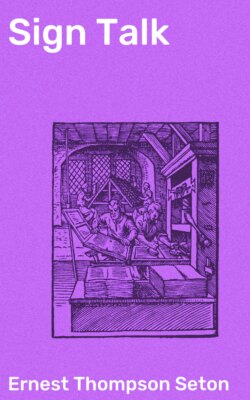Читать книгу Sign Talk - Ernest Thompson Seton - Страница 11
На сайте Литреса книга снята с продажи.
THE INDIAN CODE
ОглавлениеTable of Contents
So far as I can learn, no student hitherto has compared the various methods without being convinced that the American Indian Sign Language is the best extant. It is theoretically perfect and practically complete. In order to make this evident, I must offer a definition and some comparative details.
A true Sign Language is an established code of logical gestures to convey ideas; and is designed as an appeal to the eye, without the assistance of sounds, grimaces, apparatus, personal contact, written or spoken language, or reference to words or letters; preferably made by using only the hands and adjoining parts of the body.
Measured by these standards, there is only one true Gesture Language in the field to-day; that is the sign-talk of the American Indians. It is established over the whole area of the Great Plains; and, though varied locally, is essentially the same from Saskatchewan to Rio Grande.
In general, it is claimed that there are two well-marked dialects of this: the northern, which is a whole hand and a two-hand dialect; the central and southern, which is a finger and one-hand dialect.
The former is better for far signalling; the latter for conversation. There are, however, many exceptions to these rules; and, in any case, they are so close akin that Indians from opposite extremes of the Plains have no difficulty in conversing with each other.
The Cheyennes originally lived in a central region where they had intercourse with a dozen tribes whose spoken language differed from their own; so they became very expert sign-talkers, perhaps the best. They have amplified to the number of several thousand signs, and simplified until theirs has become largely a one-hand code; therefore, as far as possible, I make the Cheyenne sign-talk my standard. All signs herein given I have found in use among the southern Cheyennes and are understood to be Cheyenne except when another source is specifically mentioned.
Clark gives first place among gesture talkers to the Cheyennes and their associates the Arapahoes, whose sign-talk was the same, though their speech was very different, so that the signs for which he is authority may also be considered Cheyenne.
The signs given me as Indian by Sheeaka and his friend, Tom Frosted, should be cautiously received if one would study the ancient code. Sheeaka had in his family a deaf-mute, who probably imported some signs from the Deaf Code, as indicated.
In cases where there were different signs for the same idea, I have selected the simplest and clearest, the least like other signs; or, other things equal, the one most extensively used, preferring a one-hand to a two-hand sign.
Usually that sign is best from the locality where the idea is most familiar. Thus the Sioux sign for “tree squirrel” is poor; the Modoc sign is very good. The Navaho signs for “domestic sheep” are numerous and clearly differentiated; those of the north are not, and refer back to the “bighorn.” Southern signs for “snow” are descriptive and cumbrous, while those of the northern tribes are simple and perfect.
